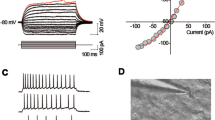Summary
-
1.
The calcium antagonists D-600 (1–10µM) and diltiazem (10–25µM) inhibit K+-evoked release of [3H]norepinephrine from guinea pig cerebral cortical vesicular preparations. The inhibition of release is partially reversed by increasing concentrations of calcium to 2 mM. Diltiazem at 100µM has no effect on K+-evoked release of [3H]norepinephrine at 0.15 mM calcium but does inhibit release at 2.0 mM calcium.
-
2.
The calcium antagonist nifedipine and dantrolene, an agent purported to antagonize release of calcium from intracellular storage sites, have no effect on K+-evoked release of [3H]norepinephrine.
-
3.
The calcium antagonists D-600 (1µM) and diltiazem (10µM) inhibit K+-evoked release of [3H]dopamine from guinea pig striatal vesicular preparations. Higher concentrations of drug, namely, 10µM for D-600 and 100µM for diltiazem, cause a potentiation rather than an inhibition of K+-evoked release. The potentiation is reduced in magnitude upon raising the extracellular calcium to 2.0 mM. Indeed, 10µM D-600 then inhibits K+-evoked release of [3H]dopamine.
-
4.
The results indicate that putative calcium antagonists can have both inhibitory and facilitory effects on calcium-dependent K+-evoked release of catecholamines from central synaptic endings. Furthermore, certain peripheral calcium antagonists such as nifedipine and dantrolene may prove ineffective in central systems.
Similar content being viewed by others
References
Atlas, D., and Adler, M. (1981).α-Adrenergic antagonists as possible calcium channel inhibitors.Proc. Natl. Acad. Sci. USA 781237–1241.
Desmedt, J. E., and Hainaut, K. (1977). Inhibition of the intracellular release of calcium by dantrolene in barnacle giant muscle fibers.J. Physiol. 265565–585.
Durant, N. N., Lee, C., and Katz, R. L. (1980). The action of dantrolene on transmitter mobilization of the rat neuromuscular junction.Eur. J. Pharmacol. 68403–408.
Ebstein, R. P., and Daly, J. W. (1982). Release of norepinephrine and dopamine from brain vesicular preparations: Effects of adenosine and analogues.Cell. Mol. Neurobiol. 2193–204.
Ebstein, R. P., Seamon, K., Creveling, C. R., and Daly, J. W. (1982). Release of norepinephrine from brain vesicular preparations: Effects of an adenylate cyclase inhibitor, forskolin, and a phosphodiesterase inhibitor.Cell. Mol. Neurobiol. 2179–192.
Fairhurst, A. S., Whittaker, M. L., and Ehlert, F. J. (1980). Interactions of D600 (methoxyverapamil) and local anesthetics with rat brainα-adrenergic and muscarinic receptors.Biochem. Pharmacol. 29155–162.
Fleckenstein, A. (1977). Specific pharmacology of calcium in myocardium, cardiac pacemakers, and vascular smooth muscle.Annu. Rev. Pharmacol. Toxicol. 17149–166.
Galper, J. B., and Catterall, W. A. (1979). Inhibition of sodium channels by D600.Mol. Pharmacol. 15174–178.
Ichida, S., Okada, K., and Terao, M. (1980). Effect of verapamil on Ca-45 uptake by synaptosomes.Jap. J. Pharmacol. 30207–213.
Llinas, R. R., and Heuser, J. E. (1977). Depolarization-release coupling systems in neurons.Neurosci. Res. Progr. Bull. 15557–687.
McGee, R., Jr., and Schneider, J. E. (1979). Inhibition of high affinity synaptosomal uptake systems by verapamil.Mol. Pharmacol. 16877–885.
Meszaros, J., Kecskemeti, V., and Szegi, J. (1981). Effect of dantrolene sodium on the transmembrane potentials and contractility of guinea pig atrial myocardium.Eur. J. Pharmacol. 74181–188.
Miledi, R., and Parker, I. (1981). Diltiazem inactivates acetylcholine-induced membrane channels in skeletal muscle fibres.Biomed. Res. 2587–599.
Mulder, A. H., De Langen, C. D. J., De Regt, V., and Hogenboom, F. (1978). Alpha-receptor mediated modulation of3H-noradrenaline release from rat brain cortex synaptosomes.Naunyn-Schmiedeberg's Arch. Pharmacol. 303193–196.
Rahamimoff, R. (1976). The role of calcium in transmitter release at the neuromuscular junction. InMotor Innervation of Muscle (Thesleff, S., Ed.), Academic Press, New York, pp. 117–199.
Rahwan, R. G., Piascik, M. F., and Witiak, D. T. (1979). The role of calcium antagonism in the therapeutic action of drugs.Can. J. Physiol. Pharmacol. 57443–459.
Salata, J. J., and Jalife, J. (1982). Effects of dantrolene sodium on the electrophysiological properties of canine cardiac Purkinje fibers.J. Pharmacol. Exp. Ther. 220157–166.
Sengupta, D., Meyer, U. A., and Carafoli, E. (1980). Binding of dantrolene sodium to muscle intracellular membranes.FEBS Lett. 11737–38.
Author information
Authors and Affiliations
Rights and permissions
About this article
Cite this article
Ebstein, R.P., Daly, J.W. Release of norepinephrine and dopamine from brain vesicular preparations: Effects of calcium antagonists. Cell Mol Neurobiol 2, 205–213 (1982). https://doi.org/10.1007/BF00711148
Received:
Revised:
Accepted:
Issue Date:
DOI: https://doi.org/10.1007/BF00711148




